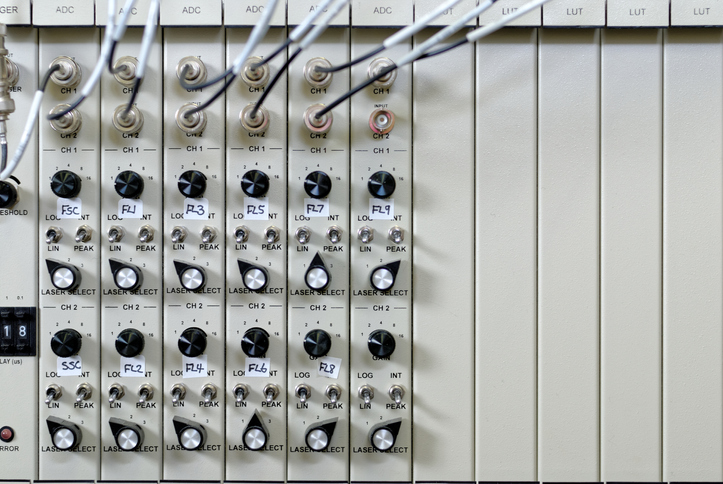What Is Flow Cytometry?
When researchers handle complex biological samples, they often need to isolate a specific cell population. The process of separating a cell type of interest from others in a heterogeneous mixture, known as cell isolation or cell sorting, allows scientists to perform downstream analysis for life sciences or other research areas.

There are many cell sorting methods researchers have at their disposal; one such method is based in flow cytometry.
Flow cytometry is a standard research technique with many advantages and disadvantages, and the good news is that it can be used in combination with other cell separation technologies—like Akadeum’s buoyancy-activated cell sorting (BACS™) microbubbles—to improve the quality and viability of sorted cells.
What Is Cytometry?
Cytometry is the measurement of cell characteristics. This technique allows researchers to gather data on a large number of individual cells, which can then be independently analyzed.
One cytometric method used in clinical and research laboratories is flow cytometry.
What Does Flow Cytometry Measure?
Flow cytometry is a cell analysis technique that measures both physical and chemical characteristics of individual cells—like volume, size, count, morphology, protein expression health, and lifecycle stage—in a biological sample. It allows researchers to evaluate thousands of cells per second in a rapidly flowing single-cell suspension.
This tool is used across the life sciences to statistically characterize cells by multiple parameters at the same time and without harming the sample.
How Do Flow Cytometers Work?
Flow cytometers generally have the same components and follow the same process, but some machines are set up to sort cells in addition to analyzing cell characteristics.
Main Components
The three main parts of a flow cytometer are the fluidics system, the optics system, and the electronics system.
The fluidics system transports the cells from the sample tube, organizes them into a single-file steam of cells, and sends them to the flow cytometer. The optics system includes lenses, lasers, filters, and other pieces that use light to generate a photocurrent used by the flow cytometer to detect cell characteristics. The electronics system digitizes and processes that data.
These components all work together to analyze cells.
The Process
Here is the flow cytometry procedure:
- The cell sample is placed in the flow cytometer, and the fluidics system prepares the sample into a single-cell stream.
- As the cells move through the flow cytometer, they encounter the optics system and are illuminated by a light source, such as a laser beam.
- The light hits each individual cell and scatters based on the structures inside and outside the cell.
- Data generated from the photocurrent is detected by the electronics system, which can then be measured and correlated with targeted cell characteristics.
After the cells are processed, they are no longer needed. Usually, they are passed to a waste container; but, if the flow cytometer has cell sorting capabilities, the cells are instead separated into tubes for downstream analysis.
Can Flow Cytometers Separate Cells?
Flow cytometers are analytical machines that measure cell characteristics; on their own, they do not separate cells. However, some flow cytometers can be set up with the additional capability to sort cells and recover the subsets for further experimentation.
Cell sorters can use the fluorescence components of flow cytometers to divert specific cell populations into separate tubes. Other flow cytometers with cell sorting abilities use droplet technology to isolate cell populations. These flow cytometry cell sorters are known as fluorescence-activated cell sorting (FACS) machines.
Flow Cytometry vs. FACS
The terms flow cytometry and FACS are often used interchangeably, but they are not actually the same things. FACS is a specialized type of flow cytometry that applies fluorescent markers to cells and takes advantage of the single-cell stream to target and isolate cell groups.
In the flow cytometry process, the light source illuminates cell characteristics and that data is collected. In FACS-enabled machines, the laser will also excite any fluorescent labels associated with the cell. This additional component is how FACS sorts cells according to light scattering.
Check out our article on FACS vs. flow cytometry if you’re interested in learning more.
Advantages and Disadvantages
Flow cytometry-based cell sorting has its pros and cons. The advantages are clear: Researchers can separate cells based on a large number of variables that go beyond surface markers, such as size and metabolic status. This technique also has a high throughput, with the ability to analyze—literally—millions of cells.
Unfortunately, there are some disadvantages. The sorting process is slow; allowing the cells to flow too quickly could be detrimental, and increased cell viability comes at the cost of a decreased stream flow rate. Total recovery is also quite low, so researchers must start with a large quantity of cells—not a good thing when working with rare cells. Additionally, on top of everything, flow cytometers are expensive to maintain and operate, and they require highly skilled personnel.
Thankfully, there is some good news: By combining the benefits of flow cytometers with the cost savings and effectiveness of cell isolation methods like BACS™ microbubbles, researchers can improve the purity and viability of their sorted cells.
Are Microbubbles Compatible with Flow Cytometers?
Of course they are.
Akadeum’s BACS™ microbubbles can be used in combination with other cell separation methods, like flow cytometry-based cell sorting. And, because our microbubble technology is based on buoyancy, it has the distinct advantage of being rapid and gentle, saving researchers time and money while improving cell viability.



